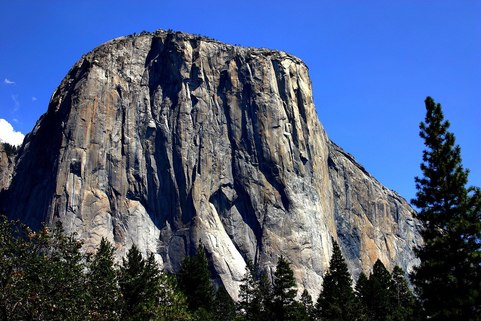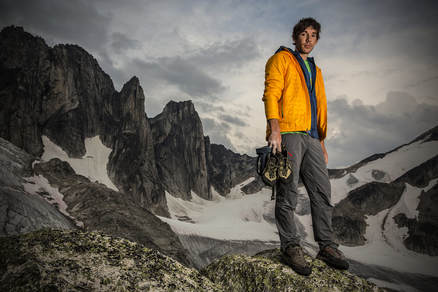 In case you don’t follow rock climbing as a sport, you should know that last year the “moon landing” of rock climbing happened: Alex Honnold Free-soloed El Capitan in Yosemite! In case you don’t know what this means, let me break it down for you. El Capitan This is a massive granite monolith in Yosemite national park in California that rises vertically from the floor of Yosemite Valley a distance of almost 3000 feet. It is considered one of the ultimate big-wall climbs in the world, and is a central part of a rock climbing culture in the US replete with wild anecdotes, traditions, and larger than life characters. Free soloing There are several styles of rock climbing. Most climbers making their way up very difficult walls insert gear in the cracks in the rock and attach ropes to the gear in order to hoist themselves up. Some of the best climbers in the world often use a style called Free Climbing where they just use their hands and feet to climb the wall and employ gear and ropes only for protection in case of a fall. Free soloing is the most dangerous variety of climbing. In free soloing, climbers free-climb the rock but without using any gear or ropes for protection. If they make a mistake, they fall and die.  Alex Honnold Alex Honnold is a US rock climber who specializes in free solo climbing, and who has dazzled the world with some of the most daring big wall climbs ever attempted by a human being, all without a rope to hold him in case he falls. So, put the three above together. Yes, Alex Honnold climbed the massive hulk of El Capitan using no ropes for protection in case of a fall. Any distraction, any slip, or any handhold or foothold that broke apart would have sent him careening towards the valley floor below. If you want to get an idea of what it means to climb El Capitan you can check out the following Google Maps link. But why am I writing about rock climbing if this is a science blog? The reason is the following.
From what I have described above you would think that Alex Honnold is the best climber in the world, right? Actually, this is not true, and even he admits it. Of course, there is no doubt that Alex is an elite climber, among the best in the world, but there are many other climbers that are technically more gifted and stronger than Alex when it comes to climbing. Any of these climbers can climb what Alex climbs and then some (but here is the key distinction) as long as they are protected by a rope. Place any of these climbers thousands of feet above the ground on a vertical rock face with nothing to prevent them from falling, and they will be unable to climb stretches of rock that they would have normally strolled over. They would likely panic and fall to their deaths. This is where Alex excels above all rock climbers in the world: he is able to control fear and focus on the climb. The late Dean Potter, who was also a free soloist, best described this challenge when he was trying to walk a tightrope in Yosemite. Potter said that if he suspended the rope a few feet above the ground, he had no problem in crossing it. However, when he suspended exactly the same stretch of rope thousands of feet above the valley floor he would often fall when trying to cross it. He correctly deduced that success in walking the rope depended on the mind, and after a few tries with a safety harness he was able to successfully accomplish this feat unprotected several times. When rock climbers are exposed to situations where they deal with increased risk, their stress hormone levels and anxiety are increased. It is in these situations that an area of the brain called the amygdala, which is involved in the production of the sensation of fear, is activated. Moderate activation of the amygdala is often a good thing. There are people with a condition called Urbach-Wieth Disease where the amygdala becomes calcified and ceases to work. As a result of this, these people can’t experience fear, and this is a big problem in their lives. Fear is a healthy response to many things, and it keeps us away from danger. However, overactivation of the amygdala can lead to panic, and loss of control and capacity for rational thought. Most rock climbers will tell you that the best place to panic is not while clinging to a near vertical section of a rock wall on tiny handholds and footholds thousands of feet above the ground. Some neuroscientists became interested in Alex and convinced him to allow them to perform an experiment. The scientists viewed his brain with magnetic resonance imaging while he was being shown a series of ghastly images designed to activate a normal person’s amygdala. As a control the scientists also imaged the brain of another rock climber. The results indicated that although Alex does have an amygdala in his brain, it was not activated by the images. However, the amygdala of the control climber lit up as expected. The scientists speculated that either Alex’s amygdala doesn’t activate normally, or other brain regions are able to inhibit its activation. Alex rejects the notions that he doesn’t experience fear while rock climbing without a rope for protection. Nevertheless, he claims that he can just put it aside without allowing it to get in the way of focusing on the climb. This ability is key for achieving what he has done. His free-solo of El Capitan required him to maintain his concentration for almost 4 hours of climbing. This allowed him to accomplish the feat without a single mistake, which was vital as only one mistake could have gotten him killed. The above not only highlights how the differences in wiring in our brains can make us experience the reality around us in very different ways, but also the role that emotions such as fear can have in our life. Fear is, of course, not only restricted to rock climbing. Will I develop a serious health problem? Does so and so love me? Are my children safe? Will I get mugged? Will I keep my job? Should I get involved in this business? Will my economic situation improve? What will the president tweet next? Uncertainty about these and many other situations can generate anxiety, stress, and fear of different levels of intensity, some of which can produce inappropriate responses that will hurt rather than help us. Fear and stress can also cause alterations in the wiring of the brain that can affect our behavior even when the events that triggered the fear are not present anymore such as in post-traumatic stress disorder (PTSD). This is why the study of fear and related phenomena is an active area of research in the biological and psychological sciences. Going back to Alex, his climb of El Capitan will be featured in a National Geographic movie (yes, it was filmed!) entitled, Free Solo, that will be released this fall on select theaters. Alex has also written a book, Alone on a Wall, where he details his many climbing exploits before his monumental El Capitan climb. Note: the film about Alex's free solo climb won an Oscar for best documentary. El Capitan image by Mike Murphy is used here under an Attribution-Share Alike 3.0 Unported license. The image from Alex’s website is displayed here under the legal doctrine of Fair Use as described on Section 107 of the Copyright Act.
0 Comments
|
Details
Categories
All
Archives
June 2024
|
 RSS Feed
RSS Feed